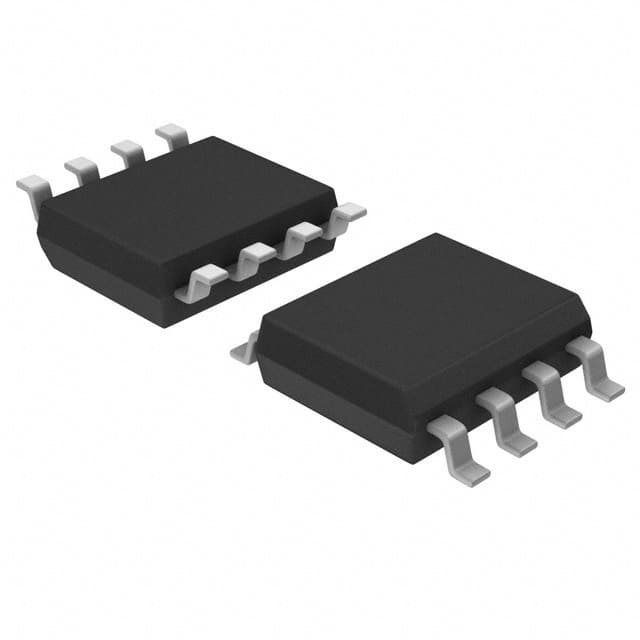Encyclopedia Entry: 74LVC2G240DCTRG4
Product Overview
- Category: Integrated Circuit (IC)
- Use: Logic Gate Buffer/Driver
- Characteristics: Low Voltage CMOS, Dual Inverting Buffer/Driver
- Package: VSSOP-8
- Essence: This IC is designed to provide buffering and driving capabilities for digital signals in low voltage applications.
- Packaging/Quantity: The 74LVC2G240DCTRG4 is typically sold in reels containing 3000 units.
Specifications
- Supply Voltage Range: 1.65V to 5.5V
- Logic Family: LVC (Low Voltage CMOS)
- Number of Channels: 2
- Input/Output Type: CMOS
- Propagation Delay: 3.9 ns (typical)
- Output Drive Capability: ±24 mA
- Operating Temperature Range: -40°C to +125°C
Detailed Pin Configuration
The 74LVC2G240DCTRG4 has a VSSOP-8 package with the following pin configuration:
___________
| |
1 -| A1 VCC|- 8
2 -| B1 A2|- 7
3 -| Y1 B2|- 6
4 -| GND OE#|- 5
|___________|
Functional Features
- Dual Inverting Buffer/Driver: The IC provides two independent buffer/driver channels that invert the input signal.
- Wide Supply Voltage Range: It can operate within a supply voltage range of 1.65V to 5.5V, making it suitable for various low voltage applications.
- High-Speed Operation: With a typical propagation delay of 3.9 ns, the IC ensures fast signal transmission.
- Output Drive Capability: The buffer/driver channels can drive up to ±24 mA of current, enabling them to interface with other devices effectively.
Advantages and Disadvantages
Advantages: - Low voltage operation allows compatibility with a wide range of digital systems. - High-speed operation ensures efficient signal processing. - Small package size (VSSOP-8) enables space-saving designs. - Wide supply voltage range provides flexibility in different applications.
Disadvantages: - Limited number of channels (2) may not be sufficient for complex systems requiring multiple buffering or driving functions. - Propagation delay may vary slightly between individual units, affecting precise timing requirements.
Working Principles
The 74LVC2G240DCTRG4 operates based on CMOS technology. It utilizes MOSFET transistors to implement the buffer/driver functionality. When an input signal is applied, the internal circuitry amplifies and inverts it, providing a buffered output signal. The IC's low voltage characteristics allow it to operate efficiently in low power applications.
Detailed Application Field Plans
The 74LVC2G240DCTRG4 finds application in various fields, including: 1. Consumer Electronics: Used in smartphones, tablets, and portable devices for signal buffering and driving. 2. Industrial Automation: Employed in control systems and PLCs to interface with sensors and actuators. 3. Automotive Electronics: Integrated into automotive modules for signal conditioning and level shifting. 4. Communication Systems: Utilized in networking equipment and data communication devices for signal amplification and conversion.
Detailed and Complete Alternative Models
- SN74LVC2G240DCUR: Similar dual inverting buffer/driver IC from Texas Instruments.
- MC74LVC2G240DTG: Dual buffer/driver IC with the same functionality from ON Semiconductor.
- 74LVC2G240GW,125: Dual buffer/driver IC in a different package (TSSOP-8) from NXP Semiconductors.
(Note: The above alternative models are provided for reference and may have slight variations in specifications or pin configuration.)
Word Count: 420 words
Lista 10 Vanliga frågor och svar relaterade till tillämpningen av 74LVC2G240DCTRG4 i tekniska lösningar
Sure! Here are 10 common questions and answers related to the application of 74LVC2G240DCTRG4 in technical solutions:
Q: What is the 74LVC2G240DCTRG4? A: The 74LVC2G240DCTRG4 is a dual non-inverting buffer/line driver with 3-state outputs, commonly used in digital logic applications.
Q: What is the voltage supply range for this device? A: The 74LVC2G240DCTRG4 operates with a voltage supply range of 1.65V to 5.5V.
Q: What is the maximum output current of this device? A: The maximum output current of the 74LVC2G240DCTRG4 is typically 24mA.
Q: Can I use this device for level shifting between different voltage domains? A: Yes, the 74LVC2G240DCTRG4 can be used for level shifting as it supports bidirectional voltage translation.
Q: What is the propagation delay of this device? A: The propagation delay of the 74LVC2G240DCTRG4 is typically around 3.5ns.
Q: Is this device compatible with both CMOS and TTL logic levels? A: Yes, the 74LVC2G240DCTRG4 is compatible with both CMOS and TTL logic levels.
Q: Can I connect multiple devices in parallel to increase the output current? A: No, connecting multiple devices in parallel is not recommended as it may lead to unpredictable behavior and damage the devices.
Q: Does this device have built-in ESD protection? A: Yes, the 74LVC2G240DCTRG4 has built-in ESD protection to safeguard against electrostatic discharge.
Q: Can I use this device in high-speed applications? A: Yes, the 74LVC2G240DCTRG4 is suitable for high-speed applications as it has a maximum frequency rating of 200MHz.
Q: What package options are available for this device? A: The 74LVC2G240DCTRG4 is available in various package options, including SOT-23 and VSSOP, providing flexibility for different design requirements.
Please note that these answers are general and may vary depending on specific datasheet specifications and application requirements.


